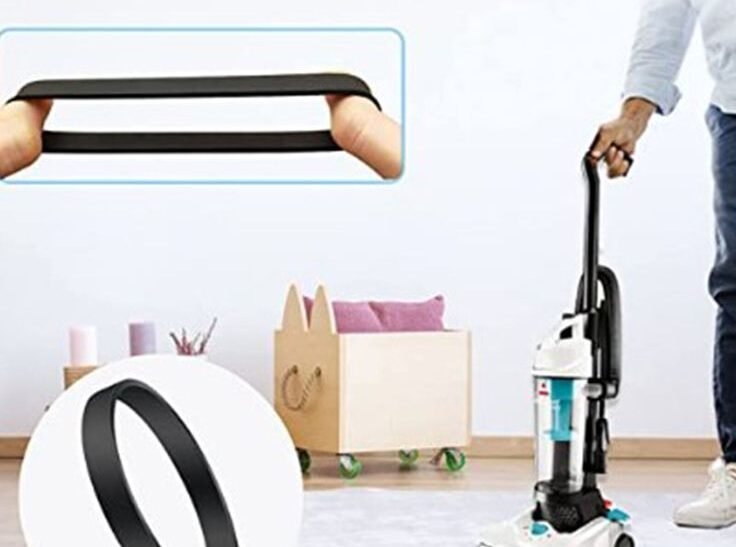Understanding Vacuum Cleaner Belts
Vacuum cleaner belts are essential components within vacuum systems, playing a critical role in ensuring effective cleaning performance. These belts serve the function of connecting the motor to the brushes or agitators of the vacuum, enabling them to rotate and effectively lift dirt and debris from various surfaces, including carpets and hard floors. The interaction between the motor and the drive belts is crucial, as it determines the suction power and the efficiency of dirt removal.
There are several types of belts for vacuum cleaners, each designed for specific models and vacuum brands, highlighting that not all vacuum cleaners utilize the same belt type. For instance, Riccar vacuum cleaners often incorporate unique belt designs tailored to their specific cleaning mechanisms. Understanding the types of belts available can aid consumers in making informed decisions when it comes to maintenance or replacement. Common varieties include flat belts, round belts, and geared belts. The choice of belt can significantly impact the vacuum cleaner’s overall functionality and longevity.
It is crucial to ensure that the correct belts for vacuum cleaners are used; an incompatible belt can lead to reduced efficiency or potential damage to the vacuum cleaner. When belts become worn or stretched over time, they may slip off the motor pulley or lose their grip on the brushes, directly affecting the vacuum’s performance. Regularly inspecting vacuum cleaner belts and replacing them as required can enhance the efficacy of the cleaning process, ensuring that the machine operates at peak performance.
In conclusion, understanding how vacuum cleaner belts function and the importance of selecting the correct type for specific vacuum models, including Riccar vacuum cleaners, can significantly influence cleaning results and overall satisfaction with the appliance. Proper maintenance and timely replacement of these belts are essential for sustaining optimal vacuum performance.
Identifying Signs of Belt Wear in Vacuum Cleaners
Recognizing the signs that indicate your vacuum cleaner belt may require replacement is essential to maintain optimum performance and avoid potential damage. Vacuum cleaners, including Riccar vacuum cleaners, rely on belts to power their brushes and agitation mechanisms, which are crucial for effective cleaning. One of the most significant indicators of a worn or broken belt is reduced suction power. If you notice that your vacuum struggles to pick up dirt and debris, this may signal a decline in belt performance.
Another critical sign to consider is the presence of unusual noises coming from the machine. If your vacuum cleaner starts producing grinding, squealing, or rattling sounds, this could imply that the belt is slipping or has broken altogether. These noises often indicate that the belt is no longer functioning correctly, which can ultimately hinder the vacuum’s cleaning capabilities.
It is also essential to monitor the brushes or agitators on your vacuum cleaner. If the brushes are not spinning as they should, even when the vacuum is turned on, this often points to a malfunctioning belt. In many cases, the belt may become stretched or worn over time, leading to inadequate rotation of the brush head and a decrease in cleaning efficiency.
To effectively diagnose the performance of your vacuum cleaner and identify whether the belt needs replacing, maintain a checklist that includes observing suction power, auditory signs, and brush functionality. Regular maintenance and timely replacement of belts for vacuum cleaners will help prolong the life of your machine and ensure it performs at its best. Taking these steps not only saves you time and effort in cleaning but also enhances the overall longevity of your vacuum cleaner, including models like Riccar vacuum cleaners.
How to Maintain and Replace Your Vacuum Cleaner Belt
Maintaining and replacing the belt in your vacuum cleaner is crucial for ensuring its longevity and optimal performance. Regular maintenance checks can help extend the life of your Riccar vacuum cleaners and prevent avoidable breakdowns. Typically, it is recommended to inspect your vacuum cleaner belt every three to six months, depending on how frequently you use the appliance. If you vacuum daily, consider a shorter interval for checks.
To start, gather the necessary tools: a screwdriver, scissors, and a replacement belt specifically designed for your vacuum model, ensuring it is compatible with Riccar vacuum cleaners. Before beginning the replacement, make sure the vacuum is unplugged to avoid any accidental start-ups, which could lead to injury.
Begin the process by locating the belt cover, which is usually at the bottom of the cleaner. Use your screwdriver to remove any screws securing the cover and gently lift it off. You might find the existing belt either broken or stretched. If the belt is intact, carefully cut it using scissors to avoid damaging surrounding components.
Once the old belt is removed, check the pulleys and components for any debris that may have built up over time. Clean these areas to ensure a smooth operation. Now, position the new belt over the motor shaft and then loop it around the brush roller. Make sure the belt is seated properly in any grooves to prevent slipping. Finally, replace the belt cover and reattach any screws you removed earlier.
After reassembly, plug in the vacuum cleaner and power it on, listening for any unusual noises that may indicate improper installation. By following these simple steps, you can effectively maintain and replace your vacuum cleaner belts, ensuring your Riccar vacuum cleaners operate efficiently and serve you well for years to come.
Choosing the Right Vacuum Cleaner Belt
Selecting the appropriate vacuum cleaner belt is crucial for maintaining the performance and longevity of your device. Vacuum cleaner belts come in various sizes and materials, each designed to fit specific models and functions. Understanding these differences will assist you in making a knowledgeable choice, particularly if you own brands like Riccar vacuum cleaners, known for their durability and efficiency.
The first step in choosing the right belt is to check the manufacturer’s recommendations. Most manufacturers provide clear guidance on the type of belt compatible with their vacuum models. This information can often be found in the user manual or on the manufacturer’s official website. Ensuring compatibility is essential, as a belt that does not match your specific model can lead to operational inefficiencies or even damage the vacuum cleaner.
In addition to considering size, it is essential to evaluate the material used in the vacuum cleaner belts. Belts can be made from rubber, polyurethane, or other compounds, and each material offers different benefits in terms of elasticity and durability. Rubber belts, for instance, are typically more elastic but may degrade faster, while polyurethane belts are known for their longer lifespan and resistance to wear.
When it comes to purchasing replacement belts, there are several options available. Retailers both online and in physical stores offer a variety of vacuum belts. It is advisable to compare prices across multiple platforms to ensure affordability while also considering the quality of the belts. Trusted brands often have a reputation for high-quality products, making them a safer bet for those looking to maintain their Riccar vacuum cleaners effectively.
By understanding the types, sizes, and materials of vacuum cleaner belts and sourcing them from reputable retailers, you can ensure your vacuum cleaner functions efficiently while prolonging its lifespan.











